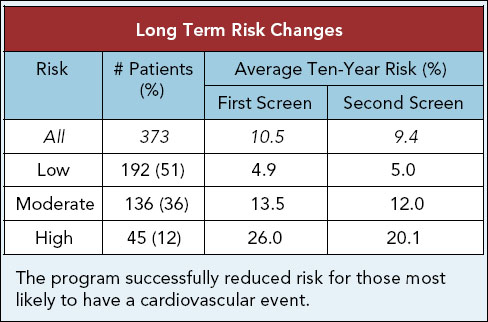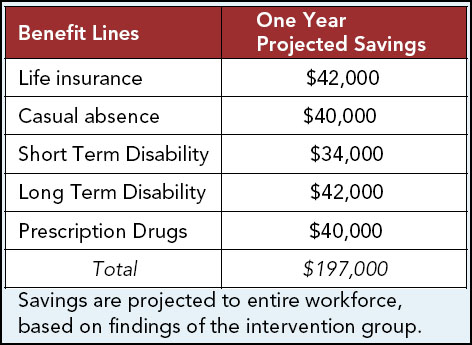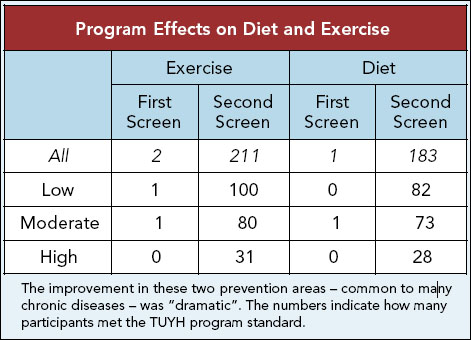
Turn Up Your Heart Drives Better Health at DaimlerChrysler
|
bh IN BRIEF
Health claim cost is a major competitiveness issue among US automakers. In 2001, DaimlerChrysler Canada Inc. (DCCI), with the support of the Canadian Auto Workers (CAW), launched a health strategy to address the impact of mostly preventable disease on their active and retired workforce…and their costs.
The first major program, Tune Up Your Heart, was introduced in 2003. Almost 20% of local workers were screened, and half agreed to participate in a series of interventions designed to reduce their cardiovascular (CV) risk over one year. The results indicated sustained gains in health status, diet, exercise, drug compliance, and smoking behaviour. A financial analysis demonstrated small but positive gains.
|
|
The Rationale
This is certainly not news – controlling health care costs is perhaps the major competitive challenge for North American automakers. A document prepared by General Motors (GM), Ford and DaimlerChrysler (DC) in the US shows the cost of medical benefits tipped the scale at an average US$1,275 per vehicle and about US$4,600 per worker. This year, GM will spend a staggering US$5.6 billion on health services for 150,000 active and 460,000 retired employees.
The comparable cost is about US$800 per worker in Ontario. This nearly 6:1 cost ratio is also not news – our healthcare system has often been described as a competitive advantage for Canadian employers. Why then would DaimlerChrysler Canada Inc. (DCCI) decide to introduce a major health promotion program?
The biggest killer of Canadian men is cardiovascular disease, aggravated by a lifetime of inadequate exercise, smoking, and poor diet. Men typically pay less attention to their personal health. DCCI’s Canadian workforce is 87% male, with an average age of 45. DCCI knew health risks and health costs are positively linked – that is, cost rises as the number of health risks increases. Further, their obligations for the health benefits of 12,000 retirees means they cannot avoid paying for the long-term effects of poor lifestyle.
A multi-phase health business plan was established in 2001 under the brand name Working Towards Wellness, which has been endorsed by the Canadian Auto Workers (CAW) union.
The Program
Tune Up Your Heart (TUYH) was a year-long cardiovascular (CV) health promotion pilot operating in DCCI’s headquarters and assembly plant in Windsor, ON. It used a computer model (CV Risk Manager) to estimate the ten-year probability of incurring a CV event, such as a heart attack, based on both modifiable (blood pressure, smoking, total/HDL cholesterol ratio) and non-modifiable (age, sex, family history) risk factors. Based on personal risk level, each participant received a plan to help improve his/her exercise levels, diet, medication use, or to quit smoking.
Of 6,500 workers in Windsor, 1,200 (18.5%) enrolled in the screening phase, and 580 of those agreed to participate in the intervention program. That program consisted of individual goal-setting, medication review, follow-up contact, group education sessions, and even a visit to a grocery store with a dietitian. After one year, 373 workers (64% of 580) were re-tested. Employees were grouped into low, medium, and high-risk cohorts at onset and follow-up. Since most participants were shift workers at the plant, the participation levels are quite impressive.
The program successfully reduced risk for those most likely to have a cardiovascular event.
Initiated and funded by Pfizer, TUYH involved DCCI, the CAW, Solutions in Health, Manulife, Green Shield, and the Windsor-Essex Public Health Unit. Pfizer Canada also provided access to CV assessment tools, and CV program development expertise, and engaged Aon Consulting to create a cost impact model and tool.
The Target
The overall goal was to sustain those in good health, and move those at higher risk of CV disease to lower risk. TUYH aimed to improve the ability of employees to manage their own health, including better compliance with prescribed heart medications.

The Results
Health – Cardiovascular risk declined on average, with the biggest decline for those at highest risk. About 10% of the smokers in the intervention group quit their habit during the program. The biggest recorded changes were related to diet and exercise levels. Both variables improved in half of those in the intervention group, although literally, only one or two people ate appropriately or exercised enough at the beginning of the study. Compliance with heart medications improved about 50% overall.
Financial – Aon Consulting was retained to assess cost savings in life insurance, absence, STD, LTD and drug plans based on improved CV health in the intervention group.
The savings were initially calculated for one year, and then projected over all employees. Actual intervention group savings in the first year were about $4,300, which grew to $197,000 when applied to the entire active workforce. The savings were quite evenly distributed across all five benefits. Over ten years, the projected savings were $2,010,000 for the whole company, assuming 15% drug inflation, 3% annual increases in the other four salary-based lines, and a discount factor of 5%.

Conclusion
TUYH demonstrated that a worksite cardiovascular health screening and education program can save an employer money. However, year one savings were achieved only because costs for planning, implementation, and evaluation were excluded. (These administrative costs would normally be part of an economic evaluation.) The TUYH findings are consistent with the results of similar programs reported in Canada and the United States. The 18-month gap between first test and re-test also indicated improved lifestyle behaviours could be sustained.

Next Steps
The partnership of companies that delivered the program deserves recognition and they got it: DCCI and the CAW were the first joint recipients of a Healthy Workplace Award from the National Quality Institute. The next step? “To be determined” within TUYH, but there is good reason to be hopeful. In May 2005, the CAW pledged $1 million to fight addiction and mental health…and challenged other organizations to do the same.
|
The Bottom Line Commentary
Wow! Hats off to DaimlerChrysler Canada for investing in their employees with such a proactive, high-impact and far-reaching contribution to improved workplace (and corporate) health. Heart disease is the #1 killer in Canadian men and women. Importantly, for employers, the journey towards that fatal endpoint is characterized by a plethora of absences, disability, drug costs and other resource demands that weaken The Bottom Line. This is all the more tragic when much of this can be very simply and cheaply prevented.
It is well known that "doing the right things right" creates added value almost by osmosis. Similarly, doing the "right things" in this project will, in very little time, distill into a clear and significant return:
- Employee education, empowerment, and a sense of control.
- A "halo" effect on family members by reducing employee stress and distraction.
- More reason to trust the company through its demonstrated concern for workers, willingness to invest, and take a longer-term view.
We also learned this during my time at Mc Neil Consumer Healthcare, the Canadian Tylenol Company of Johnson and Johnson. J&J uses a model that identifies benefits to self, employer, and community from the company’s sponsorship of good health benefits and programs. DCCI appears poised to experience the same health and economic advantages right across their benefit program. Add to these many indirect beneficial cost impacts such as improved productivity, quality, innovation, and flexibility through reduced presenteeism, and it’s easy to see that, for a relatively modest investment, there can be a healthy Tune Up to your Bottom Line.
George Cuthbert > CA, ACMA
Categories: Bottom Line
